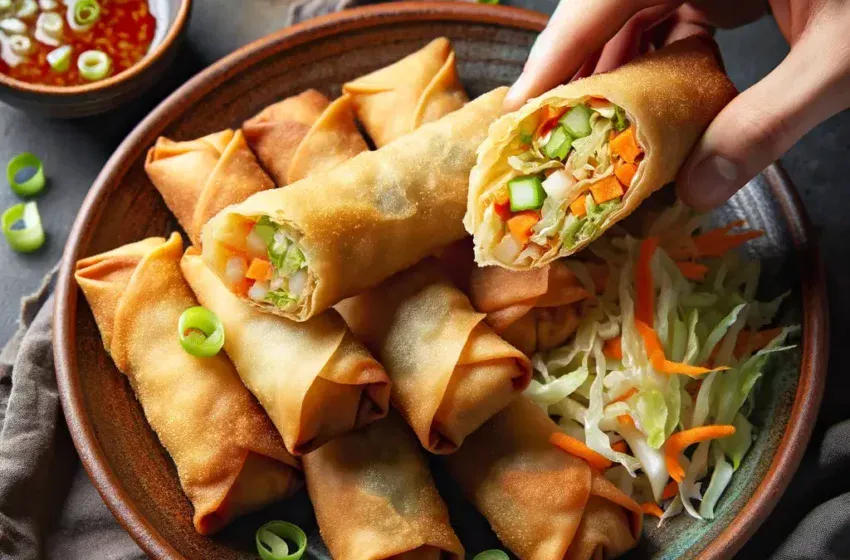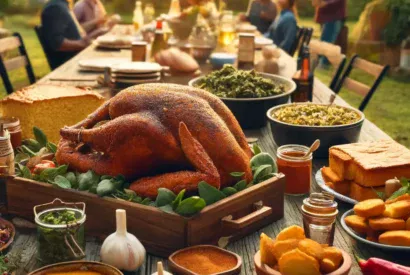Vegetable Lumpia: A Delightful Culinary Journey from My Kitchen
During my culinary explorations, I’ve stumbled upon a dish that not only tantalizes the taste buds but also brings a wholesome experience to the dining table – the Vegetable Lumpia. This Filipino delicacy, akin to the spring rolls found in other Asian cuisines, has become a staple in my kitchen. The crispy exterior, paired with a hearty, vegetable-packed interior, offers a delightful contrast that I found irresistibly inviting.
The process of making Vegetable Lumpia is an art in itself, one that I eagerly embraced. Let me guide you through the steps to create this exquisite dish, ensuring you can replicate the vibrant flavors and textures in your own kitchen.
Vegetable Lumpia Recipe:-
- Preparation Time
30-45 minutes - Cooking Time
15-20 minutes - Serves
4-6 adults - Difficulty
Medium
Ingredients
- Wrapper: Use ready-made lumpia wrappers, available at Asian markets, for convenience and authentic texture.
- Filling:
- Vegetables: A mix of shredded carrots, cabbage, and bean sprouts forms the bulk of the filling. The combination of these vegetables provides a sweet, crunchy, and slightly earthy taste.
- Seasonings: Garlic, onions, and soy sauce are essential for achieving the deep, umami flavor characteristic of lumpia. Salt and pepper are adjusted to taste.
- Protein (optional): For an added layer of flavor, tofu or tempeh can be included, making the lumpia even more satisfying.
Instructions
- Prepare the Filling:
- Begin by sautéing garlic and onions in a large skillet until they’re translucent and fragrant. This base will infuse your lumpia with a mouth-watering aroma that’s hard to resist.
- Add the shredded vegetables and stir-fry until they’re just tender. It’s crucial not to overcook them to maintain their crunch.
- If using, add the diced tofu or tempeh and continue to cook for a few more minutes.
- Season the mixture with soy sauce, salt, and pepper. Let it cool slightly before assembling the lumpia.
- Assemble the Lumpia:
- Carefully separate the lumpia wrappers. Place a tablespoon of the vegetable mixture on one end of a wrapper, leaving enough space at the edges to fold.
- Fold the sides of the wrapper inward, then roll the wrapper tightly around the filling. Use a bit of water to seal the edge.
- Fry the Lumpia:
- Heat oil in a deep skillet over medium-high heat. Once hot, fry the lumpia in batches, turning occasionally, until they’re golden brown and crispy.
- Drain them on paper towels to remove excess oil.
- Serve:
- Serve the lumpia hot with a dipping sauce of your choice. A simple vinegar-based sauce with garlic, or a sweet and sour sauce, complements the flavors perfectly.
In my experience, the Vegetable Lumpia not only serves as a delicious appetizer or snack but also opens up conversations about the rich culinary traditions of the Philippines. Each bite offers a crunch that unravels layers of flavors, from the savory filling to the subtle, earthy undertones of the vegetables, all encased in a golden wrapper that’s pleasantly crisp.
The beauty of Vegetable Lumpia lies in its versatility. Feel free to experiment with different vegetables or add a pinch of spice for an extra kick. The dish is forgiving and can be tailored to suit any palate, making it a fantastic option for gatherings or a simple family dinner.
As I savored the Vegetable Lumpia, with its complex textures and flavors, I was reminded of the joy that cooking brings. It’s not just about the food but the experience of crafting something beautiful and delicious. The Vegetable Lumpia, with its simple ingredients and intricate flavors, is a testament to the culinary diversity that enriches our world. Give this recipe a try, and let the Vegetable Lumpia take you on a delightful culinary journey right from your kitchen.
You Can Also Read:- Pollo Saltado Recipe
FAQ :- Vegetable Lumpia Recipe
- What is Vegetable Lumpia?
- Vegetable Lumpia is a Filipino spring roll filled with a mixture of seasoned vegetables and sometimes tofu or tempeh, wrapped in a thin crepe pastry skin and fried until crispy.
- Can I make lumpia wrappers at home?
- Yes, you can make lumpia wrappers at home using a batter of flour, water, and salt, thinly spread over a hot pan, but for convenience, ready-made wrappers are recommended.
- What vegetables are best for lumpia filling?
- Cabbage, carrots, and bean sprouts are popular choices for their texture and flavor, but you can also use green beans, sweet potatoes, or any vegetables you prefer.
- Can I add meat to the vegetable lumpia?
- Absolutely. While this recipe focuses on vegetables, ground pork, chicken, or shrimp can be added to the filling for a non-vegetarian version.
- Is there a gluten-free option for lumpia wrappers?
- Yes, there are gluten-free lumpia wrappers available made from rice flour. Check Asian markets or specialty health food stores.
- How do I prevent lumpia wrappers from drying out?
- Keep the wrappers covered with a damp cloth or plastic wrap until ready to use to prevent them from drying out.
- Can I bake the lumpia instead of frying?
- Yes, for a healthier option, you can bake lumpia at 400°F (200°C) until golden brown, though the texture may be slightly different from frying.
- What dipping sauces pair well with vegetable lumpia?
- Vinegar-based sauces, sweet and sour sauce, or a simple mixture of soy sauce and lemon juice are great options.
- How do I store leftover lumpia?
- Cooked lumpia can be stored in an airtight container in the refrigerator for up to 3 days and reheated in an oven or air fryer to crisp up.
- Can vegetable lumpia be frozen?
- Yes, uncooked lumpia can be frozen in a single layer on a baking sheet, then transferred to a freezer bag for up to 3 months. Fry directly from frozen, adjusting cooking time as needed.
- How do I roll lumpia tightly without tearing the wrapper?
- Avoid overfilling and roll firmly but gently, starting with the edge closest to you, then folding in the sides before finishing the roll.
- What oil is best for frying lumpia?
- Neutral oils with a high smoke point, such as vegetable oil, canola oil, or peanut oil, are best for frying lumpia.
- Can I use an air fryer to cook lumpia?
- Yes, lumpia can be cooked in an air fryer at 390°F (200°C) for about 10-15 minutes, turning halfway through, until golden brown.
- How do I make a vegan version of vegetable lumpia?
- Use tofu or tempeh as a protein source and ensure your wrappers are vegan. Also, check the ingredients of your dipping sauce.
- What’s the difference between lumpia and spring rolls?
- Lumpia is a type of spring roll originating from the Philippines, often characterized by its thin wrapper and savory fillings, including a vegetable-only version.
- Can I make lumpia ahead of time?
- Yes, you can prepare and roll the lumpia ahead of time and refrigerate them for a few hours before frying, or freeze for longer storage.
- How do I make my lumpia extra crispy?
- Ensure the oil is hot enough (around 350°F or 175°C) before frying, and don’t overcrowd the pan to maintain the oil temperature.
- Is there a healthier filling alternative to the traditional one?
- Incorporate more fibrous vegetables like kale or spinach, and use quinoa or chickpeas for added protein and texture.
- Can I use a different type of mushroom instead of tofu for a meaty texture?
- Yes, mushrooms like shiitake or oyster mushrooms can provide a meaty texture and umami flavor to the filling.
- How do I avoid soggy lumpia?
- Drain the vegetable filling thoroughly before wrapping, and make sure the oil is hot enough before frying.
- What’s the best way to seal lumpia wrappers?
- A paste made from flour and water or simply dabbing water along the edge of the wrapper before rolling it up tightly will help seal it.
- Can I make lumpia with sweet fillings?
- Yes, lumpia can also be made with sweet fillings like banana and jackfruit, known as “turon” in Filipino cuisine.
- How do I cut vegetables uniformly for lumpia filling?
- Use a mandoline slicer or julienne peeler for even, thin slices that cook uniformly.
- Can I substitute soy sauce with another seasoning?
- Yes, tamari or liquid aminos can be used as gluten-free alternatives to soy sauce.
- What can I do if my lumpia wrappers tear while rolling?
- Patch tears with a small piece of another wrapper, using water to help it adhere, or simply double-wrap with another layer.
- Is there a specific type of cabbage that works best in lumpia?
- Green cabbage is most commonly used for its crisp texture and mild flavor, but Napa cabbage can also be a good alternative.
- How do I make lumpia without frying?
- Besides baking, you can also pan-fry lumpia in a non-stick skillet with a minimal amount of oil for a less greasy option.
- Can I add spices to the lumpia filling?
- Absolutely, feel free to experiment with spices like ginger, turmeric, or chili flakes to add heat and depth of flavor.
- What’s the best way to serve lumpia at a party?
- Serve lumpia on a platter with dipping sauces on the side, allowing guests to choose their preferred sauce.
- How can I make my lumpia filling more flavorful?
- Sauté the filling ingredients with aromatics like garlic, onion, and ginger, and season well with soy sauce, salt, and pepper to taste. Adding a splash of sesame oil can also enhance the flavor.












